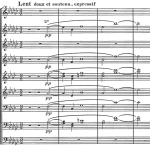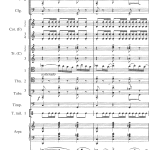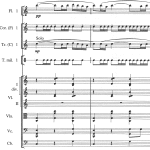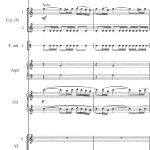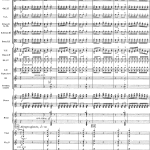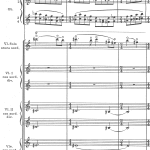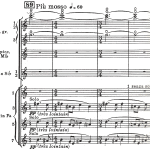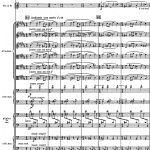Octave doubling is a type of parallel doubling, of course, but here the term is used to denote doublings at other intervals, for instance the third (cf. the Tchaikovsky example, figure 32). In tonal music, a parallel doubling usually involves adjusting the parallel interval (most often third, fifth or sixth) to conform to the current key or scale. Even more than octave doubling, parallel doubling results in increased volume and density. A growing interest in parallel doublings besides octave, third and sixth is noticeable in music from the early 20th century onward.
Figure 42 · Debussy, Le martyre de Saint Sébastien, m. 1
From beginning to end, Maurice Ravel’s famous Bolero exemplifies a methodically orchestrated and continuous crescendo, slowly but steadily growing in intensity and volume of sound. Eventually, as the volume reaches forte, parallel doublings in regular or diminished triads saturate nearly the entire orchestral texture.
Figure 43 · Ravel, Bolero, number 15, m. 3
Bolero is based on a single theme that is repeated over and over, first introduced by solo winds with very low intensity: a flute in its lowest register, in which the instrument’s fundamental sound has few overtones, and a clarinet in the neutral mid-range; gradually the intensity increases, and a relatively high bassoon is followed by a high (E-flat) clarinet. Ravel completely avoids the intense solo sound of the oboe with its abundance of high-pitched overtones, choosing instead the softer oboe d’amore with fewer high or penetrating overtones. Following this, Ravel contrives a sonority that appears to be yet another gentle sounding oboe by combining a muted trumpet with a flute in octave doubling. The flute possesses no high-pitched, strong overtones, and here functions as an “artificial” first overtone in the sound spectrum of the muted trumpet, which would otherwise have been characterized by softer, higher pitched overtones[1].
Figure 44 · Ravel, Bolero, number 5, m. 3
Next, a solo tenor saxophone followed by a solo soprano saxophone, but still no oboe. First in bar 167, almost precisely midway through the piece, the oboe makes its first appearance, not functioning as a solo instrument, but as part of a timbral mixture: parallel doubling in fifths, together with oboe d’amore, English horn and clarinets.
And then a far-famed passage with a timbre clearly influenced by a mixture stop on the organ.
Figure 45 · Ravel, Bolero, number 8, m. 3
The term “mixture” refers to a stop that consists of multiple ranks of pipes, creating an “artificial” overtone spectrum in which the individual pitches are not perceived by the listener – usually octave and fifth, often third and sometimes minor seventh, depending on traditions and individual organ builders. In the example above, the piccolos add the second and fourth overtone to the melody played by the horn, while the celesta adds the first and third. Since overtones are fixed intervals independent of tonality, Ravel simply notates the second overtone of the C major melody in G major and the fourth overtone in E major.
This shows that doubling not only results in a blend of tone colors, but allows the creation of artificial, even “virtual” instruments solely by means of orchestration– invented instruments, so to say, with a specific potential for certain sonorities or articulations. In the above example, the sound of the horn is modified by artificial overtones to result in a truly “fictitious” instrument. Note that besides writing in different keys, Ravel also indicates individual dynamics, as the artificial overtones must be sufficiently soft to create the illusion of imperceptible and genuine overtones.
Maintaining a consistent identity is required of any doubling and can be ensured in a number of ways. At first glance, the Messiaen example below appears to be a linear parallel doubling. A comparison of the intervals in the transition from m. 2–3 reveals that whereas most instruments descend by a major second, the 2nd violins ascend by an augmented fourth. But since all voices share the same rhythm, articulation and linear contour, the status of the segment as melodic unisono can hardly be questioned (cf. the earlier definition of unisono as something that behaves as one voice or line).
Figure 46 · Messiaen, Turangalîla Symphony, 5th movement, number 1, m. 4
The following example demonstrates freely shaped parallel motion with similarities to doubling and – in combination with repeated notes – includes the interval of a minor seventh.
Figur 47 · Stravinsky, Petrushka, “Danse Russe,” number 64
Borderline situations between extended parallel doubling and polyphony are not rare. In such cases, individual assessment must focus on the relative strength of independent melodic movement on the one hand (dividing a musical pattern into different segments) and rhythmic unison on the other (tying elements together into a single segment).
An essential variation principle in all orchestral music is change of sonority and timbre. The short motives in Stravinsky’s Le sacre are subject to infinite transformation, notably with respect to timbre. The following three examples share the same melody: figure 48 presents the melody with a mixture-like octave doubling. Here the second overtone of the alto flute melody is reinforced by a solo violin playing harmonics. The next example (figure 49) presents the melody in a freely treated doubling at the third and fifth below. The final passage (figure 50) combines this doubling with contrary motion similar to inversion.
Figur 48 · Stravinsky, Le sacre du printemps, number 83
Figur 49 · Stravinsky, Le sacre du printemps, number 89
Figur 50 · Stravinsky, Le sacre du printemps, number 91
· · ·
Next · Partial Doubling and Heterophony (Chapter 4. Unison and Doubling)
· · ·
[1]It should be pointed out that the mute referred to here is a standard (“straight”) mute that enhances high-pitched overtones. Other brass mutes like “cup” or “velvet” reduce these high overtones and result in a more closed, less oboe-like sound.
